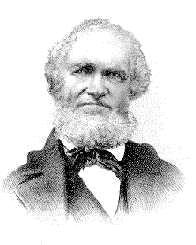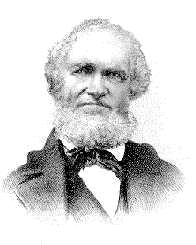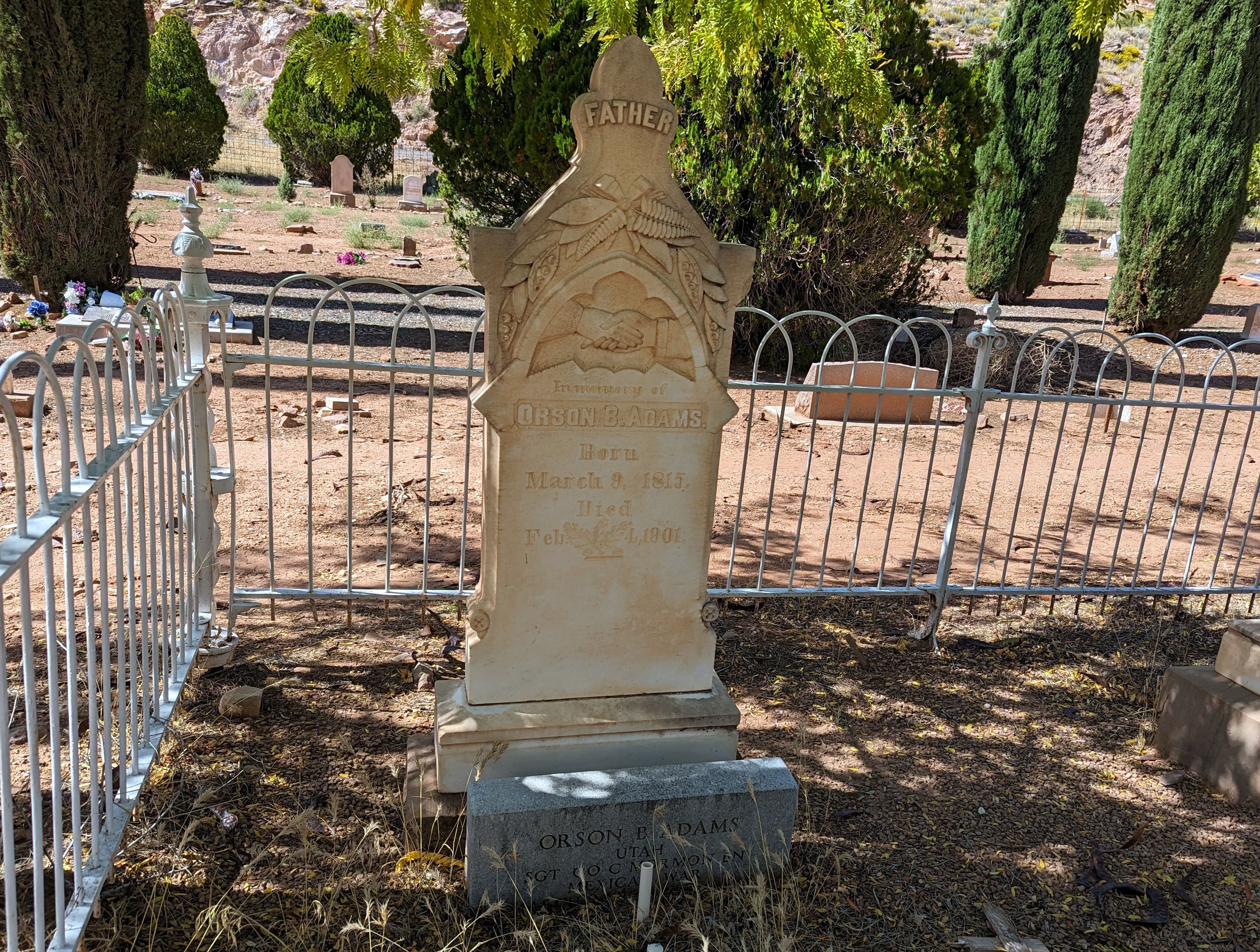Married - Susannah Smith, 20 Mar 1836, Grayson County, Kentucky
History - Orson was a member of the Mormon Battalion, Company C, Sergeant of Sick Detachment under Captain James Brown. He and his wife Susannah lost two children at birth then adopted a son, John S. Page Adams. John did not go on the march with them and grandparents cared for him. Susan had been raised in the home of a doctor and was able to bring much comfort to the company.
Orson and Susann Adams, who came from Pueblo with detachment of sick of the battalion that came to the valley in the summer of 1847. John was was three came on to the valley with mule team in Jedediah M. Grant's company. They reached Salt Lake City in the autumn of 1847. His parents arriving a few days before him. Orson & Susann built them a home out on Mill Creek near the great old cedar, the one tree of which the valley could boast. His father O.B. Adams put up the first sawmill on City Creek.
In the second summer of the settlement the crickets came and food was scarce. The soldiers wages were almost exhausted. He spent fifty dollars for a hundred pounds of flour and the same amount of shorts. One morning Orson Adams came in and announced to his wife his determination to go to the States for supplies. He asked for food enough for his first lunch. For the rest he had his gun and trusted to it and a kind providence for sustenance.
There were always the Indians to be reckoned with, and the pioneer women learned to use a gun to protect themselves and their children. One day, while Orson was away n this trip east Chief Walker and some of his braves had taken too much "fire water". They were tearing around the Mill Creek homestead, Mother Adams sat in the door of her little home all day with the gun across her knees and her children John and Betsy in the room behind her. Besides John she had taken into her home two orphaned children, John Henderson and Betsy Caddle.
When the express came in the fall, it brought a message from Orson Adams, telling his wife when she could expect him home if his team could hold out that long. The time came and passed and he didn't come. Mrs. Adams had a team of oxen yoked to a wagon and with John Henderson, only fourteen, she started to his relief. Being unable to manage the animals they never unyoked them from the wagon. For two nights the animals slept in their traces and with the first streak of dawn they were on their way. At the end of their third day, they met the husband whose team was almost exhausted.
In the early winter of 1851, the Adams family took their cattle and goods in response to call and went with George A. Smith and company to settle on Little Salt Lake, a colony known as Parowan. On the way out from where Beaver now is, they had to cross a ledge down which the hundred and fifty wagons and old brass cannon had to be lowered with ropes. The first company over the cliff moved on to Little Creek and made camp. The second made camp at Wheat Grass, while the third was still laboring over the ledge. Late in the evening the two camps were roused by a volley from the cannon and several rapid rifle shots. To the startled colonists it could mean but one thing -- Indians. Those who were able tumbled out, some even forgot to dress in the excitement, and rushed out into the snow to learn what it was all about. Mrs. Adams calmly advised one man to go back and dress so that "in case there was trouble he would be in shape to do something." Sam Hamilton, from the first camp and Sam Lewis from the second went out to reconnoiter. They found Company Three celebrating the safe descent from the ledge and the arrival into the valley.
The next day they moved on to the river where they found a quaking aspen pole standing, still bearing the remnant of the flag placed by some unknown hands. They camped by the flag pole on the south side of the river until the fort was built. After a short time at the fort, the Adams family moved to Red Creek where they took up a homestead.
"Times were hard in those first years at Parowan" says John Adams. "The beaver built dams in the creek and shut off the water supply. The men would go in the day and clear them out and in the night the beaver would put them in again. The wheat was beginning to head but it was burning. The people held a meeting and prayed for relief. That night it snowed about twelve inches. The people were disheartened. They had water but the wheat all lay flat. During the day the sun came out and melted the snow. The wheat straightened up and they had a good crop."
Late in the fall the Indians would come into town to glean in the grain fields. Indian children were the only playmates John Adams had while they lived on Red Creek. He learned their language and their temperaments and earned their friendship, an experience that served him well throughout his life.
In his fourteenth year John Adams was left with his mother, while his father obeyed a call to a mission to the Spring Valley in the White Mountains of Nevada. This time Orson Adams undertook to prepare a home for his family before he moved them out. These Spring Valley settlers were attacked by Indians and lost all their horses and cattle. They were left empty handed with no animals for farm work. After two years, Adams returned to Parowan worn out and discouraged. His report induced the authorities to give up the mission. Express riders were to be sent to notify the settlers that they were released from the call. John Osborne and Orson Adams were asked to take the message but because of the illness of the elder Adams, John offered to go in his stead. The offer was accepted. This began a long period of service as express rider.
In 1863 Orson B. Adams was called to Harrisburg to preside. Then the Blackhawk war broke out and there was a raid on Parowan. Parowan settlers sent a telegram to John asking him to come to their aid in defending the stock. They built a look-out tower thirty feet high on Little Creek. There he with three others stayed as picket guard. One man always was on the tower watching the country around. There were four other men whom they called "whisper in" who carried reports daily to the town. During this time, all community cattle were kept in a nearby forty acre meadow that was fenced. There was no more loss to the Indians.
* Orson Bennett Adams Home
*Mormon Battalion, Company C
Married - Susannah Smith, 20 Mar 1836, Grayson County, Kentucky
History - Orson was a member of the Mormon Battalion, Company C, Sergeant of Sick Detachment under Captain James Brown. He and his wife Susannah lost two children at birth then adopted a son, John S. Page Adams. John did not go on the march with them and grandparents cared for him. Susan had been raised in the home of a doctor and was able to bring much comfort to the company.
Orson and Susann Adams, who came from Pueblo with detachment of sick of the battalion that came to the valley in the summer of 1847. John was was three came on to the valley with mule team in Jedediah M. Grant's company. They reached Salt Lake City in the autumn of 1847. His parents arriving a few days before him. Orson & Susann built them a home out on Mill Creek near the great old cedar, the one tree of which the valley could boast. His father O.B. Adams put up the first sawmill on City Creek.
In the second summer of the settlement the crickets came and food was scarce. The soldiers wages were almost exhausted. He spent fifty dollars for a hundred pounds of flour and the same amount of shorts. One morning Orson Adams came in and announced to his wife his determination to go to the States for supplies. He asked for food enough for his first lunch. For the rest he had his gun and trusted to it and a kind providence for sustenance.
There were always the Indians to be reckoned with, and the pioneer women learned to use a gun to protect themselves and their children. One day, while Orson was away n this trip east Chief Walker and some of his braves had taken too much "fire water". They were tearing around the Mill Creek homestead, Mother Adams sat in the door of her little home all day with the gun across her knees and her children John and Betsy in the room behind her. Besides John she had taken into her home two orphaned children, John Henderson and Betsy Caddle.
When the express came in the fall, it brought a message from Orson Adams, telling his wife when she could expect him home if his team could hold out that long. The time came and passed and he didn't come. Mrs. Adams had a team of oxen yoked to a wagon and with John Henderson, only fourteen, she started to his relief. Being unable to manage the animals they never unyoked them from the wagon. For two nights the animals slept in their traces and with the first streak of dawn they were on their way. At the end of their third day, they met the husband whose team was almost exhausted.
In the early winter of 1851, the Adams family took their cattle and goods in response to call and went with George A. Smith and company to settle on Little Salt Lake, a colony known as Parowan. On the way out from where Beaver now is, they had to cross a ledge down which the hundred and fifty wagons and old brass cannon had to be lowered with ropes. The first company over the cliff moved on to Little Creek and made camp. The second made camp at Wheat Grass, while the third was still laboring over the ledge. Late in the evening the two camps were roused by a volley from the cannon and several rapid rifle shots. To the startled colonists it could mean but one thing -- Indians. Those who were able tumbled out, some even forgot to dress in the excitement, and rushed out into the snow to learn what it was all about. Mrs. Adams calmly advised one man to go back and dress so that "in case there was trouble he would be in shape to do something." Sam Hamilton, from the first camp and Sam Lewis from the second went out to reconnoiter. They found Company Three celebrating the safe descent from the ledge and the arrival into the valley.
The next day they moved on to the river where they found a quaking aspen pole standing, still bearing the remnant of the flag placed by some unknown hands. They camped by the flag pole on the south side of the river until the fort was built. After a short time at the fort, the Adams family moved to Red Creek where they took up a homestead.
"Times were hard in those first years at Parowan" says John Adams. "The beaver built dams in the creek and shut off the water supply. The men would go in the day and clear them out and in the night the beaver would put them in again. The wheat was beginning to head but it was burning. The people held a meeting and prayed for relief. That night it snowed about twelve inches. The people were disheartened. They had water but the wheat all lay flat. During the day the sun came out and melted the snow. The wheat straightened up and they had a good crop."
Late in the fall the Indians would come into town to glean in the grain fields. Indian children were the only playmates John Adams had while they lived on Red Creek. He learned their language and their temperaments and earned their friendship, an experience that served him well throughout his life.
In his fourteenth year John Adams was left with his mother, while his father obeyed a call to a mission to the Spring Valley in the White Mountains of Nevada. This time Orson Adams undertook to prepare a home for his family before he moved them out. These Spring Valley settlers were attacked by Indians and lost all their horses and cattle. They were left empty handed with no animals for farm work. After two years, Adams returned to Parowan worn out and discouraged. His report induced the authorities to give up the mission. Express riders were to be sent to notify the settlers that they were released from the call. John Osborne and Orson Adams were asked to take the message but because of the illness of the elder Adams, John offered to go in his stead. The offer was accepted. This began a long period of service as express rider.
In 1863 Orson B. Adams was called to Harrisburg to preside. Then the Blackhawk war broke out and there was a raid on Parowan. Parowan settlers sent a telegram to John asking him to come to their aid in defending the stock. They built a look-out tower thirty feet high on Little Creek. There he with three others stayed as picket guard. One man always was on the tower watching the country around. There were four other men whom they called "whisper in" who carried reports daily to the town. During this time, all community cattle were kept in a nearby forty acre meadow that was fenced. There was no more loss to the Indians.
* Orson Bennett Adams Home
*Mormon Battalion, Company C
Family Members
Sponsored by Ancestry
Advertisement
Advertisement













